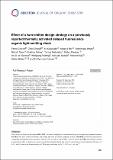Files in this item
Effect of a twin-emitter design strategy on a previously reported thermally activated delayed fluorescence organic light-emitting diode
Item metadata
| dc.contributor.author | Crovini, Ettore | |
| dc.contributor.author | Zhang, Zhen | |
| dc.contributor.author | Kusakabe, Yu | |
| dc.contributor.author | Ren, Yongxia | |
| dc.contributor.author | Wada, Yoshimasa | |
| dc.contributor.author | Naqvi, Bilal A. | |
| dc.contributor.author | Sahay, Prakhar | |
| dc.contributor.author | Matulaitis, Tomas | |
| dc.contributor.author | Diesing, Stefan | |
| dc.contributor.author | Samuel, Ifor David William | |
| dc.contributor.author | Brutting, Wolfgang | |
| dc.contributor.author | Suzuki, Katsuaki | |
| dc.contributor.author | Kaji, Hironori | |
| dc.contributor.author | Brase, Stefan | |
| dc.contributor.author | Zysman-Colman, Eli | |
| dc.date.accessioned | 2022-01-10T15:30:02Z | |
| dc.date.available | 2022-01-10T15:30:02Z | |
| dc.date.issued | 2021-12-08 | |
| dc.identifier | 276844568 | |
| dc.identifier | 4dc99977-6eae-44fe-bf03-42ec13d45db5 | |
| dc.identifier | 85122382709 | |
| dc.identifier | 000730288500001 | |
| dc.identifier.citation | Crovini , E , Zhang , Z , Kusakabe , Y , Ren , Y , Wada , Y , Naqvi , B A , Sahay , P , Matulaitis , T , Diesing , S , Samuel , I D W , Brutting , W , Suzuki , K , Kaji , H , Brase , S & Zysman-Colman , E 2021 , ' Effect of a twin-emitter design strategy on a previously reported thermally activated delayed fluorescence organic light-emitting diode ' , Beilstein Journal of Organic Chemistry , vol. 17 , pp. 2894-2905 . https://doi.org/10.3762/bjoc.17.197 | en |
| dc.identifier.issn | 1860-5397 | |
| dc.identifier.other | ORCID: /0000-0001-7183-6022/work/105956748 | |
| dc.identifier.other | ORCID: /0000-0003-0470-7356/work/105957154 | |
| dc.identifier.uri | https://hdl.handle.net/10023/24627 | |
| dc.description | Authors thank EU Horizon 2020 Grant Agreement No. 812872 (TADFlife) for funding this project. Further support was obtained by the Helmholtz Association Program at the Karlsruhe Institute of Technology (KIT). The German Research Foundation (formally Deutsche Forschungsgemeinschaft DFG) in the framework of SFB1176 Cooperative Research Centre "Molecular Structuring of Soft Matter" (CRC1176, A4, B3, C2, C6) and the cluster 3D Matter Made To Order all funded under Germany’s Excellence Strategy 2082/1--390761711 are greatly acknowledged for financial contributions. We acknowledge support from the Engineering and Physical Sciences Research Council of the UK (grant EP/P010482/1), from the International Collaborative Research Program of Institute for Chemical Research, Kyoto University (grant # 2020-37 and 2021-37), and from JSPS KAKENHI Grant Number JP20H05840 (Grant-in-Aid for Transformative Research Areas, “Dynamic Exciton”). ZZ acknowledges the financial support from the China Scholarship Council (CSC, 201606890009) for his PhD studies. EZ-C is a Royal Society Leverhulme Trust Senior Research fellow (SRF\R1\201089). | en |
| dc.description.abstract | In this work we showcase the emitter DICzTRZ in which we employed a twin-emitter design of our previously reported material, ICzTRZ . This new system presented a redshifted emission at 488 nm compared to that of ICzTRZ at 475 nm and showed a comparable photoluminescence quantum yield of 57.1% in a 20 wt% CzSi film versus 63.3% for ICzTRZ . The emitter was then incorporated within a solution-processed organic light-emitting diode that showed a maximum external quantum efficiency of 8.4%, with Commission Internationale de l’Éclairage coordinate of (0.22, 0.47), at 1 mA cm−2. | |
| dc.format.extent | 12 | |
| dc.format.extent | 2784227 | |
| dc.language.iso | eng | |
| dc.relation.ispartof | Beilstein Journal of Organic Chemistry | en |
| dc.subject | TADF emitters | en |
| dc.subject | Indolocarbazole | en |
| dc.subject | Triazine | en |
| dc.subject | Dimer | en |
| dc.subject | Blue emitters | en |
| dc.subject | Orientation | en |
| dc.subject | Outcoupling effect | en |
| dc.subject | Solution-processed OLEDs | en |
| dc.subject | QD Chemistry | en |
| dc.subject | DAS | en |
| dc.subject.lcc | QD | en |
| dc.title | Effect of a twin-emitter design strategy on a previously reported thermally activated delayed fluorescence organic light-emitting diode | en |
| dc.type | Journal article | en |
| dc.contributor.sponsor | European Commission | en |
| dc.contributor.sponsor | EPSRC | en |
| dc.contributor.sponsor | The Royal Society | en |
| dc.contributor.institution | University of St Andrews. School of Chemistry | en |
| dc.contributor.institution | University of St Andrews. School of Physics and Astronomy | en |
| dc.contributor.institution | University of St Andrews. Centre for Biophotonics | en |
| dc.contributor.institution | University of St Andrews. Condensed Matter Physics | en |
| dc.contributor.institution | University of St Andrews. EaSTCHEM | en |
| dc.identifier.doi | 10.3762/bjoc.17.197 | |
| dc.description.status | Peer reviewed | en |
| dc.identifier.url | https://doi.org/10.33774/chemrxiv-2021-sz2gb | en |
| dc.identifier.grantnumber | 812872 | en |
| dc.identifier.grantnumber | EP/P010482/1 | en |
| dc.identifier.grantnumber | SRF\R1\201089 | en |
This item appears in the following Collection(s)
Items in the St Andrews Research Repository are protected by copyright, with all rights reserved, unless otherwise indicated.

